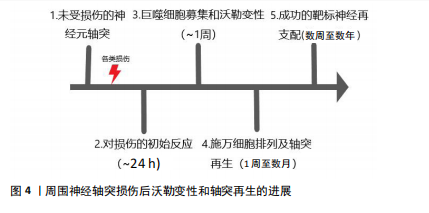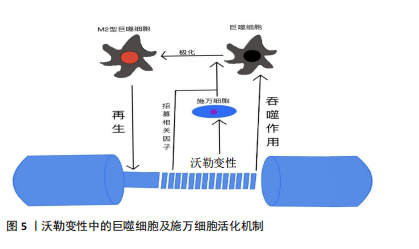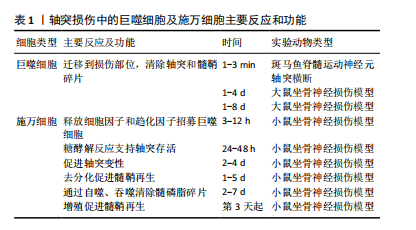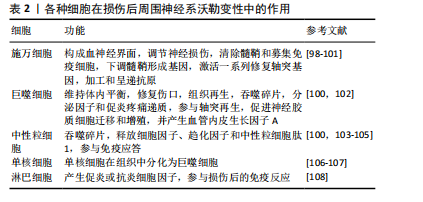[1] 刘梦婷,沈霞,鲍关爱,等.运动干预对化疗诱导周围神经损伤影响的研究进展[J].中国康复医学杂志,2023,38(1):120-123.
[2] YI S, ZHANG Y, GU X, et al. Application of stem cells in peripheral nerve regeneration. Burns Trauma. 2020;8:tkaa002.
[3] JIANG L, JONES S, JIA X. Stem Cell Transplantation for Peripheral Nerve Regeneration: Current Options and Opportunities. Int J Mol Sci. 2017; 18(1):94.
[4] LI X, GUAN Y, LI C, et al. Immunomodulatory effects of mesenchymal stem cells in peripheral nerve injury. Stem Cell Res Ther. 2022;13(1):18.
[5] ZHENG C, YANG Z, CHEN S, et al. Nanofibrous nerve guidance conduits decorated with decellularized matrix hydrogel facilitate peripheral nerve injury repair. Theranostics. 2021;11(6):2917-2931.
[6] ESTERA LA, WALSH SP, HEADEN JA, et al. Neuroinflammation: Breaking barriers and bridging gaps. Neurosci Res. 2023;197:9-17.
[7] MAENG WY, TSENG WL, LI S, et al. Electroceuticals for peripheral nerve regeneration. Biofabrication. 2022;14(4):10.
[8] YONG HYF, RAWJI KS, GHORBANI S, et al. The benefits of neuroinflammation for the repair of the injured central nervous system. Cell Mol Immunol. 2019;16(6):540-546.
[9] 火艺霖,林浩东.周围神经损伤后再生过程中许旺细胞与巨噬细胞的交互作用[J].中华显微外科杂志,2024,47(1):104-109.
[10] GAUDET AD, POPOVICH PG, RAMER MS. Wallerian degeneration: gaining perspective on inflammatory events after peripheral nerve injury. J Neuroinflammation. 2011;8:110.
[11] BROSIUS LUTZ A, CHUNG WS, SLOAN SA, et al. Schwann cells use TAM receptor-mediated phagocytosis in addition to autophagy to clear myelin in a mouse model of nerve injury. Proc Natl Acad Sci U S A. 2017;114(38): E8072-E8080.
[12] ELBERG G, LIRAZ-ZALTSMAN S, REICHERT F, et al. Deletion of SIRPα (signal regulatory protein-α) promotes phagocytic clearance of myelin debris in Wallerian degeneration, axon regeneration, and recovery from nerve injury. J Neuroinflammation.2019;16(1):277.
[13] GOMEZ-SANCHEZ JA, CARTY L, IRUARRIZAGA-LEJARRETA M, et al. Schwann cell autophagy, myelinophagy, initiates myelin clearance from injured nerves. J Cell Biol. 2015;210(1):153-168.
[14] CONFORTI L, GILLEY J, COLEMAN MP. Wallerian degeneration: an emerging axon death pathway linking injury and disease. Nat Rev Neurosci. 2014; 15(6):394-409.
[15] FITCH MT, SILVER J. CNS injury, glial scars, and inflammation: Inhibitory extracellular matrices and regeneration failure. Exp Neurol. 2008;209(2): 294-301.
[16] BUSS A, BROOK GA, KAKULAS B, et al. Gradual loss of myelin and formation of an astrocytic scar during Wallerian degeneration in the human spinal cord. Brain. 2004;127(Pt 1):34-44.
[17] ZHANG K, JIANG M, FANG Y. The Drama of Wallerian Degeneration: The Cast, Crew, and Script. Annu Rev Genet. 2021;55:93-113.
[18] 孙小玲,黄凯伟,万新贝,等.神经丝轻链蛋白在周围神经病中的应用价值探究[J].中国全科医学,2022,25(32):3977-3983.
[19] 赖木华.NeuroD1在周围神经轴突再生过程的作用及其相关机制研究[D].广州:南方医科大学,2020.
[20] PELLEGATTA M, TAVEGGIA C. The Complex Work of Proteases and Secretases in Wallerian Degeneration: Beyond Neuregulin-1. Front Cell Neurosci. 2019;13:93.
[21] MATSUDA M, HUH Y, JI RR. Roles of inflammation, neurogenic inflammation, and neuroinflammation in pain. J Anesth. 2019;33(1): 131-139.
[22] AU NPB, MA CHE. Neuroinflammation, Microglia and Implications for Retinal Ganglion Cell Survival and Axon Regeneration in Traumatic Optic Neuropathy. Front Immunol. 2022;13:860070.
[23] NIEMI JP, LINDBORG JA, ZIGMOND RE. Detection of Neutrophils in the Sciatic Nerve Following Peripheral Nerve Injury. Methods Mol Biol. 2020;2143: 207-222.
[24] BEIROWSKI B, ADALBERT R, WAGNER D, et al. The progressive nature of Wallerian degeneration in wild-type and slow Wallerian degeneration (WldS) nerves. BMC Neurosci. 2005;6:6.
[25] KALINSKI AL, YOON C, HUFFMAN LD, et al. Analysis of the immune response to sciatic nerve injury identifies efferocytosis as a key mechanism of nerve debridement. Elife. 2020;9:e60223.
[26] ZHAO XF, HUFFMAN LD, HAFNER H, et al. The injured sciatic nerve atlas (iSNAT), insights into the cellular and molecular basis of neural tissue degeneration and regeneration. Elife. 2022;11:e80881.
[27] MENORCA RM, FUSSELL TS, ELFAR JC. Nerve physiology: mechanisms of injury and recovery. Hand Clin. 2013;29(3):317-330.
[28] XU J, WEN J, FU L, et al. Macrophage-specific RhoA knockout delays Wallerian degeneration after peripheral nerve injury in mice. J Neuroinflammation. 2021;18(1):234.
[29] KERSCHENSTEINER M, SCHWAB ME, LICHTMAN JW, et al. In vivo imaging of axonal degeneration and regeneration in the injured spinal cord. Nat Med. 2005;11(5):572-577.
[30] CUNHA MI, SU M, CANTUTI-CASTELVETRI L, et al. Pro-inflammatory activation following demyelination is required for myelin clearance and oligodendrogenesis. J Exp Med. 2020;217(5):e20191390.
[31] DAVIES AJ, RINALDI S, COSTIGAN M, et al. Cytotoxic Immunity in Peripheral Nerve Injury and Pain. Front Neurosci. 2020;14:142.
[32] ROTSHENKER S. Wallerian degeneration: the innate-immune response to traumatic nerve injury. J Neuroinflammation. 2011;8:109.
[33] 雪若妍,杨华.周围神经损伤病理进程中巨噬细胞作用研究进展[J].中华耳科学杂志,2021,19(1):126-130.
[34] 黄善敏,许林杰,谢翠梅,等.巨噬细胞在周围神经损伤中的作用研究进展[J].神经损伤与功能重建,2023,18(10):597-600.
[35] CAMPANA WM. Schwann cells: activated peripheral glia and their role in neuropathic pain. Brain Behav Immun. 2007;21(5):522-527.
[36] GRIFFIN JW, THOMPSON WJ. Biology and pathology of nonmyelinating Schwann cells. Glia. 2008;56(14):1518-1531.
[37] 张梦媛,齐建国.周围神经损伤与轴突再生[J].四川解剖学杂志,2022, 30(4):185-188.
[38] LEE HK, SHIN YK, JUNG J, et al. Proteasome inhibition suppresses Schwann cell dedifferentiation in vitro and in vivo. Glia. 2009;57(16): 1825-1834.
[39] FILOUS AR, SILVER J. “Targeting astrocytes in CNS injury and disease: A translational research approach”. Prog Neurobiol. 2016;144:173-187.
[40] MISHRA A, BANDOPADHYAY R, SINGH PK, et al. Neuroinflammation in neurological disorders: pharmacotherapeutic targets from bench to bedside. Metab Brain Dis. 2021;36(7):1591-1626.
[41] FRATI A, CERRETANI D, FIASCHI AI, et al. Diffuse Axonal Injury and Oxidative Stress: A Comprehensive Review. Int J Mol Sci. 2017;18(12):2600.
[42] KOTHUR K, WIENHOLT L, BRILOT F, et al. CSF cytokines/chemokines as biomarkers in neuroinflammatory CNS disorders: A systematic review. Cytokine. 2016;77:227-237.
[43] BOHLSON SS, TENNER AJ. Complement in the Brain: Contributions to Neuroprotection, Neuronal Plasticity, and Neuroinflammation. Annu Rev Immunol. 2023;41:431-452.
[44] SHEN J, ZHAO M, ZHANG C, et al. IL-1β in atherosclerotic vascular calcification: From bench to bedside. Int J Biol Sci. 2021;17(15):4353-4364.
[45] MURINSON BB, ARCHER DR, LI Y, et al. Degeneration of myelinated efferent fibers prompts mitosis in Remak Schwann cells of uninjured C-fiber afferents. J Neurosci. 2005;25(5):1179-1187.
[46] LIU P, PENG J, HAN GH, et al. Role of macrophages in peripheral nerve injury and repair. Neural Regen Res. 2019;14(8):1335-1342.
[47] LU CY, SANTOSA KB, JABLONKA-SHARIFF A, et al. Macrophage-Derived Vascular Endothelial Growth Factor-A Is Integral to Neuromuscular Junction Reinnervation after Nerve Injury. J Neurosci. 2020;40(50):9602-9616.
[48] MALFAIT AM, MILLER RE, BLOCK JA. Targeting neurotrophic factors: Novel approaches to musculoskeletal pain. Pharmacol Ther. 2020;211:107553.
[49] 张世雯,王艳,支金草,等.小泛素样修饰蛋白对周围神经损伤后再生作用的研究进展[J].中国康复,2022,37(3):175-178.
[50] 铁岩,李潇,杨鑫伟,等.外泌体对神经系统疾病的作用研究进展[J].医学研究杂志,2021,50(6):158-160+176.
[51] GOETHALS S, YDENS E, TIMMERMAN V, et al. Toll-like receptor expression in the peripheral nerve. Glia. 2010;58(14):1701-1709.
[52] 熊乐. TOLL样受体4信号对大鼠周围神经损伤后瓦勒变性及神经再生的影响[D].青岛:青岛大学,2018.
[53] 熊乐,张蓓,沈若武,等.TOLL样受体4拮抗剂干预周围神经损伤后的瓦勒变性[J].中国组织工程研究,2016,20(42):6308-6316.
[54] BOIVIN A, PINEAU I, BARRETTE B, et al. Toll-like receptor signaling is critical for Wallerian degeneration and functional recovery after peripheral nerve injury. J Neurosci. 2007;27(46):12565-12576.
[55] KARIKÓ K, NI H, CAPODICI J, et al. mRNA is an endogenous ligand for Toll-like receptor 3. J Biol Chem. 2004;279(13):12542-12550.
[56] BRUNN GJ, BUNGUM MK, JOHNSON GB, et al. Conditional signaling by Toll-like receptor 4. FASEB J. 2005;19(7):872-874.
[57] LEE H, JO EK, CHOI SY, et al. Necrotic neuronal cells induce inflammatory Schwann cell activation via TLR2 and TLR3: implication in Wallerian degeneration. Biochem Biophys Res Commun. 2006;350(3):742-747.
[58] HUANG JK, PHILLIPS GR, ROTH AD, et al. Glial membranes at the node of Ranvier prevent neurite outgrowth. Science. 2005;310(5755):1813-1817.
[59] DONG X, LIU S, YANG Y, et al. Aligned microfiber-induced macrophage polarization to guide schwann-cell-enabled peripheral nerve regeneration. Biomaterials. 2021;272:120767.
[60] KRATOFIL RM, SHIM HB, SHIM R, et al. A monocyte-leptin-angiogenesis pathway critical for repair post-infection. Nature. 2022;609(7925):166-173.
[61] MEYER ZU HÖRSTE G, HU W, HARTUNG HP, et al. The immunocompetence of Schwann cells. Muscle Nerve. 2008;37(1):3-13.
[62] BOMBEIRO AL, PEREIRA BTN, BONFANTI AP, et al. Immunomodulation by dimethyl fumarate treatment improves mouse sciatic nerve regeneration. Brain Res Bull. 2020;160:24-32.
[63] MIN Q, PARKINSON DB, DUN XP. Migrating Schwann cells direct axon regeneration within the peripheral nerve bridge. Glia. 2021;69(2):235-254.
[64] MARTINI R, FISCHER S, LÓPEZ-VALES R, et al. Interactions between Schwann cells and macrophages in injury and inherited demyelinating disease. Glia. 2008;56(14):1566-1577.
[65] MIZISIN AP, WEERASURIYA A. Homeostatic regulation of the endoneurial microenvironment during development, aging and in response to trauma, disease and toxic insult. Acta Neuropathol. 2011;121(3):291-312.
[66] STIRLING DP, STYS PK. Mechanisms of axonal injury: internodal nanocomplexes and calcium deregulation. Trends Mol Med. 2010;16(4): 160-170.
[67] 赵富生,武庚,武杨,等.瓦勒变性坐骨神经段对大鼠BMSCs向SCs分化的影响[J].中国病理生理杂志,2014,30(11):1946-1953.
[68] 李月珍,武庚,武杨,等.坐骨神经瓦勒变性大鼠许旺细胞生物学特性及分泌功能变化[J].中国组织工程研究,2014,18(33):5282-5287.
[69] DALAKAS MC, ALEXOPOULOS H, SPAETH PJ. Complement in neurological disorders and emerging complement-targeted therapeutics. Nat Rev Neurol. 2020;16(11):601-617.
[70] DING Z, JIANG M, QIAN J, et al. Role of transforming growth factor-β in peripheral nerve regeneration. Neural Regen Res. 2024;19(2):380-386.
[71] DOMOTO R, SEKIGUCHI F, TSUBOTA M, et al. Macrophage as a Peripheral Pain Regulator. Cells. 2021;10(8):1881.
[72] SHUBAYEV VI, ANGERT M, DOLKAS J, et al. TNFalpha-induced MMP-9 promotes macrophage recruitment into injured peripheral nerve. Mol Cell Neurosci. 2006;31(3):407-415.
[73] JANG DG, SIM HJ, SONG EK, et al. Extracellular matrixes and neuroinflammation. BMB Rep. 2020;53(10):491-499.
[74] BOSCH-QUERALT M, FLEDRICH R, STASSART RM. Schwann cell functions in peripheral nerve development and repair. Neurobiol Dis. 2023;176:105952.
[75] MA KH, HUNG HA, SVAREN J. Epigenomic Regulation of Schwann Cell Reprogramming in Peripheral Nerve Injury. J Neurosci. 2016;36(35): 9135-9147.
[76] STIERLI S, IMPERATORE V, LLOYD AC. Schwann cell plasticity-roles in tissue homeostasis, regeneration, and disease. Glia. 2019;67(11):2203-2215.
[77] BROSIUS LUTZ A, LUCAS TA, CARSON GA, et al. An RNA-sequencing transcriptome of the rodent Schwann cell response to peripheral nerve injury. J Neuroinflammation. 2022;19(1):105.
[78] CHAN AH, SCHRODER K. Inflammasome signaling and regulation of interleukin-1 family cytokines. J Exp Med. 2020;217(1):e20190314.
[79] GUPTA P, BARTHWAL MK. IL-1 β genesis: the art of regulating the regulator. Cell Mol Immunol. 2018;15(11):998-1000.
[80] BRODERICK L, HOFFMAN HM. IL-1 and autoinflammatory disease: biology, pathogenesis and therapeutic targeting. Nat Rev Rheumatol. 2022;18(8): 448-463.
[81] 郑亚妮.轴突信号Neuregulin 1在施旺细胞发育及再生修复中的作用[J].组织工程与重建外科杂志,2017,13(1):45-47.
[82] 刘思阳.枸杞多糖对糖尿病大鼠周围神经病变的保护作用及mTOR/p70S6K/自噬信号通路研究[D].银川:宁夏医科大学,2018.
[83] 白娟. TRPV1功能阻断对大鼠坐骨神经离断损伤后再生的干预作用[D].太原:山西医科大学,2018.
[84] VOET S, SRINIVASAN S, LAMKANFI M, et al. Inflammasomes in neuroinflammatory and neurodegenerative diseases. EMBO Mol Med. 2019;11(6):e10248.
[85] LI W, LIANG J, LI S, et al. Research progress of targeting NLRP3 inflammasome in peripheral nerve injury and pain. Int Immunopharmacol. 2022;110:109026.
[86] PAPAYANNOPOULOS V. Neutrophil extracellular traps in immunity and disease. Nat Rev Immunol. 2018;18(2):134-147.
[87] MISHRA MK, RAWJI KS, KEOUGH MB, et al. Harnessing the Benefits of Neuroinflammation: Generation of Macrophages/Microglia with Prominent Remyelinating Properties. J Neurosci. 2021;41(15):3366-3385.
[88] KENNEDY AD, DELEO FR. Neutrophil apoptosis and the resolution of infection. Immunol Res. 2009;43(1-3):25-61.
[89] 徐筑秋,杨晓楠,祁佐良.细胞自噬在周围神经损伤及再生中研究进展[J].中国修复重建外科杂志,2017,31(1):122-125.
[90] 苌彪,郭志远,全琦,等.大鼠感觉、运动神经瓦勒氏变性前后蛋白分析[J].解放军医学院学报,2017,38(1):55-58.
[91] BOISSONNAS A, LOUBOUTIN F, LAVIRON M, et al. Imaging resident and recruited macrophage contribution to Wallerian degeneration. J Exp Med. 2020;217(11):e20200471.
[92] TOMLINSON JE, ŽYGELYTĖ E, GRENIER JK, et al. Temporal changes in macrophage phenotype after peripheral nerve injury. J Neuroinflammation. 2018;15(1):185.
[93] WCULEK SK, DUNPHY G, HERAS-MURILLO I, et al. Metabolism of tissue macrophages in homeostasis and pathology. Cell Mol Immunol. 2022; 19(3):384-408.
[94] LI Y, KANG S, HALAWANI D, et al. Macrophages facilitate peripheral nerve regeneration by organizing regeneration tracks through Plexin-B2. Genes Dev. 2022;36(3-4):133-148.
[95] PAN D, ACEVEDO-CINTRÓN JA, SAYANAGI J, et al. The CCL2/CCR2 axis is critical to recruiting macrophages into acellular nerve allograft bridging a nerve gap to promote angiogenesis and regeneration. Exp Neurol. 2020;331:113363.
[96] BEAHRS T, TANZER L, SANDERS VM, et al. Functional recovery and facial motoneuron survival are influenced by immunodeficiency in crush-axotomized mice. Exp Neurol. 2010;221(1):225-230.
[97] BALOG BM, SONTI A, ZIGMOND RE. Neutrophil biology in injuries and diseases of the central and peripheral nervous systems. Prog Neurobiol. 2023;228:102488.
[98] LIU C, CHU D, KALANTAR-ZADEH K, et al. Cytokines: From Clinical Significance to Quantification. Adv Sci (Weinh). 2021;8(15):e2004433.
[99] GHOSH D, MERSHA TB. Publicly available cytokine data: Limitations and opportunities. J Allergy Clin Immunol. 2022;150(5):1053-1056.
[100] LAI J, WU H, QIN A. Cytokines in Febrile Diseases. J Interferon Cytokine Res. 2021;41(1):1-11.
[101] REN C, CHEN M, MU G, et al. NLRP3 Inflammasome Mediates Neurodegeneration in Rats with Chronic Neuropathic Pain. Shock. 2021; 56(5):840-849.
[102] WANG Y, CHE M, XIN J, et al. The role of IL-1β and TNF-α in intervertebral disc degeneration. Biomed Pharmacother. 2020;131:110660.
[103] SAXTON RA, GLASSMAN CR, GARCIA KC. Emerging principles of cytokine pharmacology and therapeutics. Nat Rev Drug Discov. 2023;22(1):21-37.
[104] DE SOUZA S, ROSARIO CLAUDIO J, SIM J, et al. Interleukin-10 signaling in somatosensory neurons controls CCL2 release and inflammatory response. Brain Behav Immun. 2024;116:193-202.
[105] JANCALEK R, SVIZENSKA I, KLUSAKOVA I, et al. Bilateral changes of IL-10 protein in lumbar and cervical dorsal root ganglia following proximal and distal chronic constriction injury of peripheral nerve. Neurosci Lett. 2011;501(2):86-91.
[106] MA SB, XIAN H, WU WB, et al. CCL2 facilitates spinal synaptic transmission and pain via interaction with presynaptic CCR2 in spinal nociceptor terminals. Mol Brain. 2020;13(1):161.
[107] CHEN Y, LIU S, WU L, et al. Epigenetic regulation of chemokine (CC-motif) ligand 2 in inflammatory diseases. Cell Prolif. 2023;56(7):e13428.
[108] SU H, XU F, SUN H, et al. Preparation and Evaluation of BDNF Composite Conduits for Regeneration of Sciatic Nerve Defect in Rats. J Pharm Sci. 2020;109(7):2189-2195.
|



